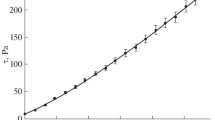Summary.
The skew part of the velocity gradient is split into objective and non-objective parts. A particular decomposition is suggested by a reinterpretation of Stokes' ideas for modeling stress in a fluid. The corresponding objective skew stretch rate appears in the correct reduced form of the Rivlin-Ericksen model. Constitutive equations for viscous fluids and viscoplastic materials are developed as special cases of this result. These equations describe a wide range of behavior observed in shearing flows.
Similar content being viewed by others
Author information
Authors and Affiliations
Additional information
Received May 6, 2002; Revised November 12, 2002 Published online: May 8, 2003
This paper is dedicated to the memory of my father, Byron Eugene VanArsdale jr. I greatly benefited from his encouragement on this project and will miss his love, kindness and humor for the rest of my life. The author also appreciated discussions with A. Berker, J. Schieber and L. Wedgewood. J.-L. Herbeaux translated portions of Boussinesq's paper [7]. J. Schieber suggested footnote (8) and helped generate Eq. (2) based on component expressions in Boussinesq's paper.
Rights and permissions
About this article
Cite this article
VanArsdale, W. Objective spin and the Rivlin-Ericksen model. Acta Mechanica 162, 111–124 (2003). https://doi.org/10.1007/s00707-002-0996-8
Issue Date:
DOI: https://doi.org/10.1007/s00707-002-0996-8



